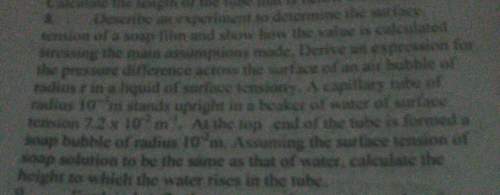
Physics, 16.07.2019 15:10 dontcareanyonemo
Microwave ovens use microwave radiation to heat food. the microwaves are absorbed by the water molecules in the food, which is transferred to other components of the food. as the water becomes hotter, so does the food. part a suppose that the microwave radiation has a wavelength of 11.2 cm . how many photons are required to heat 225 ml of coffee from 25.0 ∘c to 62.0 ∘c? assume that the coffee has the same density, 0.997 g/ml , and specific heat capacity, 4.184 j/(g⋅k) , as water over this temperature range.

Answers: 1


Other questions on the subject: Physics

Physics, 22.06.2019 02:30, mhurtado143
Agas contained within a piston-cylinder assembly undergoes three processes in series: process 12: compression with pv= constant from 1 bar and 1 liter to 4 bar. process 23: constant pressure expansion to 1 liter. process 31: constant volume calculate the pressure and volume at each state, and sketch the processes on a p-vdiagram labeled with pressure and volume values at each numbered stat
Answers: 2

Physics, 22.06.2019 13:40, andrespiperderc
Use the profile illustrated for problem (1). assume that the layer of silty sand fill (sm) is placed over the entire site. estimate the thickness of the fill (h - in feet) that will cause the effective vertical stress at the center of the clay layer to increase by 517.5 pounds per square foot.
Answers: 1

Physics, 22.06.2019 18:30, kalithekittenqueen
Aprotein molecule in an electrophoresis gel has a negative charge. the exact charge depends on the ph of the solution, but 30 excess electrons is typical. what is the magnitude of the electric force on a protein with this charge in a 1600n/c electric field? write in two significant numbers, and also in newton
Answers: 2

Physics, 22.06.2019 19:30, rprest00
Amass m = 74 kg slides on a frictionless track that has a drop, followed by a loop-the-loop with radius r = 18.4 m and finally a flat straight section at the same height as the center of the loop (18.4 m off the ground). since the mass would not make it around the loop if released from the height of the top of the loop (do you know why? ) it must be released above the top of the loop-the-loop height. (assume the mass never leaves the smooth track at any point on its path.) 1. what is the minimum speed the block must have at the top of the loop to make it around the loop-the-loop without leaving the track? 2. what height above the ground must the mass begin to make it around the loop-the-loop? 3. if the mass has just enough speed to make it around the loop without leaving the track, what will its speed be at the bottom of the loop? 4. if the mass has just enough speed to make it around the loop without leaving the track, what is its speed at the final flat level (18.4 m off the ground)? 5. now a spring with spring constant k = 15600 n/m is used on the final flat surface to stop the mass. how far does the spring compress?
Answers: 3
You know the right answer?
Microwave ovens use microwave radiation to heat food. the microwaves are absorbed by the water molec...
Questions in other subjects:

Mathematics, 19.11.2019 07:31



Computers and Technology, 19.11.2019 07:31

English, 19.11.2019 07:31


Mathematics, 19.11.2019 07:31

Biology, 19.11.2019 07:31


History, 19.11.2019 07:31

 photons
photons











